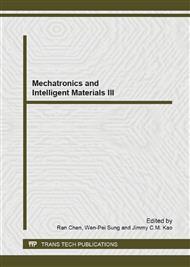[1]
Li JR, Khoo LP, Tor SB (2003) Desktop virtual reality for maintenance training: an object oriented prototype system (V-REALISM). Computers in Industry 52(1): 109-125.
DOI: 10.1016/s0166-3615(03)00103-9
Google Scholar
[2]
Abate AF, Guida M, Leoncini P, Nappi M, Ricciardi S (2009) A haptic-based approach to virtual training for aerospace industry. J Visual Lang Comput 20(1): 318-325.
DOI: 10.1016/j.jvlc.2009.07.003
Google Scholar
[3]
Haist B (2008) Setting up and managing a remote maintenance operation for fusion. Fusion Eng Des 83(1): 1841-1844.
DOI: 10.1016/j.fusengdes.2008.08.037
Google Scholar
[4]
Bellamine M, Abe N, Tanaka K, Chen P, Taki H (2004) A virtual reality based system for remote maintenance of rotating machinery. Embedded and Ubiquitous Computing, LNCS 3207: 223-232.
DOI: 10.1007/978-3-540-30121-9_16
Google Scholar
[5]
Jenab K, Zolfaghari S (2008) A virtual collaborative maintenance architecture for manufacturing enterprises. J Intell Manuf 19(1): 763-771.
DOI: 10.1007/s10845-008-0126-0
Google Scholar
[6]
Leino SP, Lind S, Poyade M, Kiviranta S Multanen P, Reyes-Lecuona A, Mäkiranta A and Muhammad A (2009) Enhanced industrial maintenance work task planning by using virtual engineering tools and haptic user interfaces. Virtual and Mixed Reality. LNCS 5622: 346-354.
DOI: 10.1007/978-3-642-02771-0_39
Google Scholar
[7]
FJAM van Houten, Kimura F (2000) The Virtual Maintenance System: A Computer-Based Support Tool for Robust Design, Product Monitoring, Fault Diagnosis and Maintenance Planning. Annals of the ClRP 49(1): 91-94.
DOI: 10.1016/s0007-8506(07)62903-5
Google Scholar
[8]
De Sa AG, Zachmann G (1999) Virtual reality as a tool for verification of assembly and maintenance processes. Computers & Graphics 23(1): 389-403.
DOI: 10.1016/s0097-8493(99)00047-3
Google Scholar
[9]
Murray N, Fernando T (2004) An immersive assembly and maintenance simulation environment. Proceedings of the Eighth IEEE International Symposium on Distributed Simulation and Real-Time Applications 04(1): 1550-6525.
DOI: 10.1109/ds-rt.2004.7
Google Scholar
[10]
Christiand, Yoon J, Kumar P (2009) A novel optimal assembly algorithm for haptic interface applications of a virtual maintenance system. J Mech Sci Technol 23(1): 183-194.
DOI: 10.1007/s12206-008-0902-y
Google Scholar
[11]
M. Teschner, B. Heidelberger, M. M¨uller, M. Gross (2004) A Versatile and Robust Model for Geometrically Complex Deformable Solids. Proc. Computer Graphics International, 312-319.
DOI: 10.1109/cgi.2004.1309227
Google Scholar


